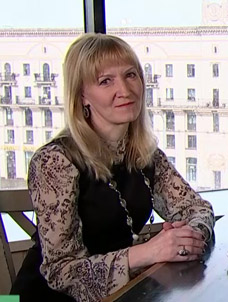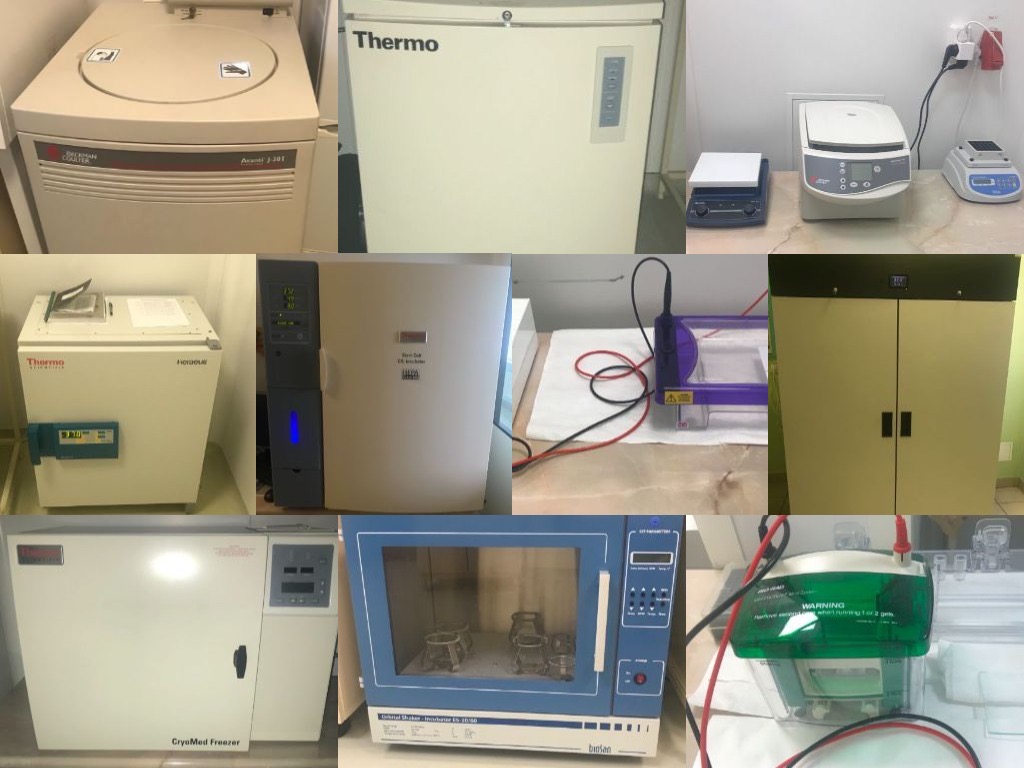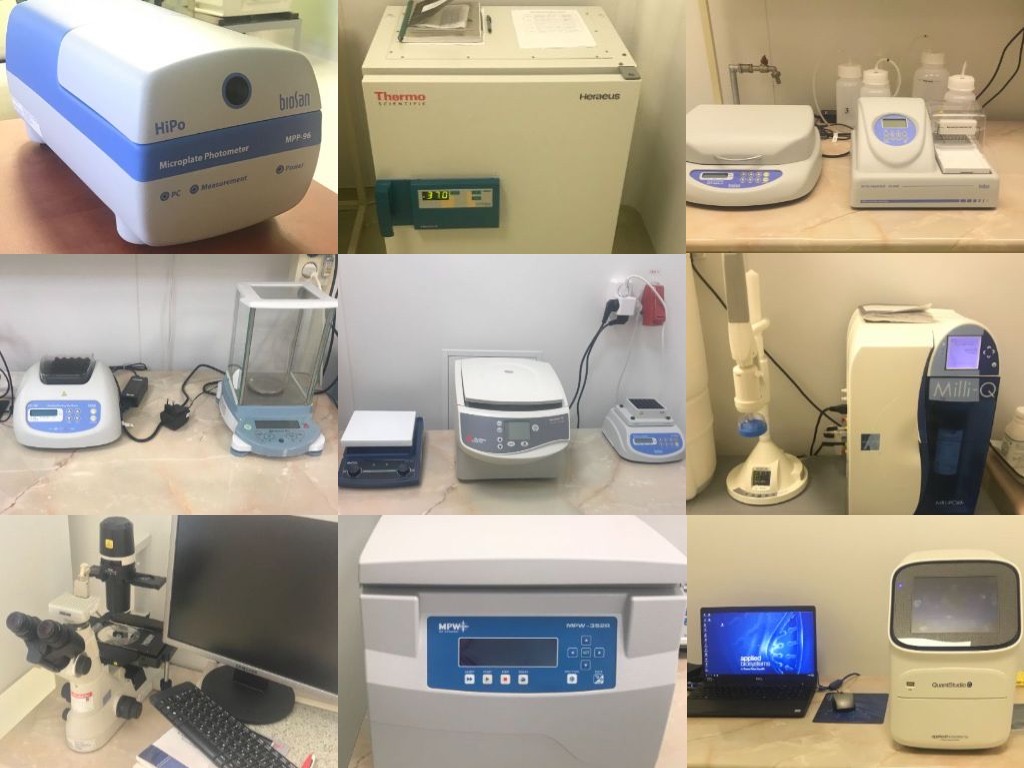conduct fundamental and applied research in the fields of immunology, allergology, rheumatology, oncology, and molecular biology;
production of medical devices;
provision of paid medical services to the population;
export of services and medical products;
training of highly qualified personnel.

Elena G. Fomina
Head of the laboratory
Ph.D. in Biological Sciences
Phone.: + 375-172 68 04 14
E-mail: feg1@tut.by
E.G. Fomina defended her dissertation work: "Recombinant technologies: a safe biotechnological platform for obtaining immunobiological preparations for diagnostics of especially dangerous, dangerous and emerging infections" specialisation 03.00.06. - virology for the degree of Doctor of Sciences.
The results of the research work are published in more than 130 scientific papers in Belarusian and foreign editions. Author of the patent: "Recombinant plasmid DNA for producing hepatitis C virus antigen", patent registration notice from November 27, 2008, registration number 11618.
Participates in training of highly qualified personnel. She is the scientific secretary of the D.03.02.01 Dissertation Council at the Republican Research and Practical Center for Epidemiology and Microbiology (specialty: 03.02.02 - Virology (medical and biological sciences), 14.02.02 - Epidemiology (medical sciences)).
She is the recipient of the grant of the President of the Republic of Belarus (Order of the President of the Republic of Belarus of March 1, 2022 № 45rp "On granting grants of the President of the Republic of Belarus for the year 2022").
E.G. Fomina participated in the development of a safe biotechnological platform for obtaining immunobiological preparations for diagnosing especially dangerous, dangerous and emerging viral infections. The platform includes:
optimization of antigen design;
efficient expression in a prokaryotic system;
improvement of purification and immobilization on polystyrene surface;
method of biological synthesis of the target gene matrix RNA within recombinant retroviral particles.
Taken together, the results obtained contribute significantly to solving an important problem in the field of virology - the improvement of serological and molecular-genetic diagnosis of viral infections. Received knowledge and successful experience can be used to develop a biotechnological platform for gene delivery and expression based on lentiviral vectors in the eukaryotic system to obtain proteins with post-translational modifications and their use in the diagnosis, prevention and treatment of viral infections.
Participates in production of the drug "Vaccine for preventing SARS-CoV-2 coronavirus infection, whole-virion inactivated" of national production.
Areas of scientific activity: molecular-genetic and immunological diagnostics of viral and protozoal infections; gene delivery and expression systems in pro- and eukaryotes; recombinant technologies for production of antigens, allergens and antibody fragments; cell biotechnology, immunology.
She was awarded the Certificate of Honour of the Ministry of Health of the Republic of Belarus in 2012 and the mark " Excellent person of health care" in 2013.
GRIGORIEVA E. ELENA, principal scientist, PhD
IRYNA V. RAMANAVA, Researcher, PhD
SIARHEI V. KORAN, Researcher
JULIANNA A. KABANOVA, Researcher
OLGA Y. PARKHOMCHUK, Junior researcher
VERANIKA V. ZVIARKO, Junior researcher
RUSINA V. VICTOROVNA, Junior research associate

Main directions of scientific activity
1. conducting a wide range of fundamental and applied research in immunology, allergology and molecular biology;
2. fundamental and applied research into gene expression and delivery into a wide range of eukaryotic cells, including professional antigen-presenting dendritic cells for use in immunotherapy of viral diseases;
3. development of virus pseudotyping technology to study cellular targets, natural hosts and virus tropism; to analyze the effectiveness of drugs that block virus entry into the cell; to find new targets for antiviral therapy; to evaluate the neutralizing activity of specific antibodies, their titer and the dynamics of their appearance;
4. development of an algorithm for authentication of human and animal cell lines based on DNA profiling and molecular-genetic methods to detect contaminant organisms;
5. maintenance and expansion of the cryobank of certified human and animal cell lines for use in virology, immunology, pharmacology, immunopharmacology, and cell biotechnology;
6. development of a technology for producing recombinant allergens using genetic engineering methods and their use in the immunotherapy of allergic diseases;
7. study of genetic variability genes of the immune system as predictors of the development of allergic diseases;
8. determination of patients' immune status based on immunophenotyping of blood lymphocytes using monoclonal antibodies to surface antigens by flow cytometry.
The following research assignments are in progress in 2022:
1) 02.15 "To develop and implement a diagnostic test system to detect different gene variants ("wild", mutant nvct, without plasmids) of chlamydia trachomatis, by real-time PCR" Government scientific and technical program "New methods of medical care", 2016 - 2020, subprogram "Infections and biological safety". Implementation deadline: 01.07.2019 - 30.06.2022.
2) Task 02.19 "Develop and implement an algorithm for authentication of human and animal cell lines based on DNA profiling and molecular genetic methods of detecting contaminant organisms" of the State Scientific and Technical Program "Genomic Technologies and Infection Safety", 2021 - 2025, subprogram "Scientific and Technical Support for Quality and Accessibility of Medical Services". Scope of work: July 1, 2021 - June 30, 2024.
3) Task 02.18. to develop an algorithm for predicting the adverse course of sepsis in children, based on a comprehensive assessment of immunological, biochemical and molecular-genetic markers of the State Scientific and Technical Program "Scientific and Technical Quality Assurance and Availability of Medical Services", 2021 - 2025, subprogram "Genomic Technologies and Infection Protection". Implementation Timeline: 01.07.2021 - 30.06.2024.
4) Task M21KOVID-028 "Creation of pseudotyped retroviral particles for safe study of tropism of the highly pathogenic SARS-CoV-2 virus", BRFFI. Timeframe: 01.02.2021 - 31.01.2023.
5) The task "To develop and implement a sensitive and safe method of determining the neutralizing activity of antibodies to SARS-CoV-2, using the technology of virus pseudotyping" of the State Program "Science-intensive Technologies and Engineering", 2021 - 2025, subprogram "Innovative Biotechnology" (task 5). Timeline: 31.01. 2022 - 31.12.2025.
6) Task 2.20 “Conducting the research as part of the development of the first domestic inactivated whole virus vaccine for the prevention of Covid-19” of the State Scientific Research Program "Translational medicine", 2021 - 2025, subprogram "Fundamental aspects of medical science". Implementation deadline: 01.07.2019 - 30.06.2022.
Perspective research:
The development of the domestic technology of production of a system for genes introduction and expression based on lentiviral vectors is a promising field of research due to the rapid development of cell technologies in the Republic of Belarus, an increase in the level of knowledge in the field of the occurrence and correction of genetic diseases, as well as prospects for the development of vaccine technology and gene therapy. The development of this technology in the future makes it possible to use it for gene therapy of somatic diseases; for delivery to professional antigen presenting cells of polyvalent mosaic immunogens for immunotherapy of viral diseases; to obtain on its basis a safe viral model with altered surface glycoproteins (pseudotyped retroviral particles).
An equally promising direction is the production of recombinant allergens in a prokaryotic expression system for use in diagnostics and allergen-specific immunotherapy, as well as the study of allelic gene polymorphisms as predictors of pollinosis. To implement this direction, it is planned to carry out the following scientific projects:
1. To study the expression of recombinant birch pollen allergens (Bet v 1 and Bet v 2) in the Escherichia coli system under the control of various promoters for further use in diagnostics and allergen-specific immunotherapy.
2. To study allelic polymorphisms of genes associated with the development of pollinosis.
Main fields of Scientific and Practical Activity
Products manufactured by the Laboratory of Immunology and Cell Biotechnology:
Mediums and solutions:
1. Hanks' solution (No. IM-7.93272/1211);
2. Versene solution (No. IM-7.93273/1211 );
3. Bovine embryo serum (No. IM-7.95291/1011);
4. Medium RPMI-1640 (No. IM-7.93271/1211);
5. Medium MEM (No. IM-7.93269/1211);
6. Medium Dulbeko DMEM (No. IM-7.93268/1211);
7. Medium 199 (№ IM-7.93270/1211).
The collection of passported human and animal cell cultures for use in virology, immunology, pharmacology, and cell biotechnology includes:
1 46-47 Vervet monkey kidney
2 A-172 Human glioblastoma
3 BGM African green monkey kidney
4 C6 Rat glial tumour
5 C8166 Human T cell leukemia
6 CaCo-2 Human colon adenocarcinoma
7 CCRF-SB Human acute lymphoblastic leukemia
8 CEM.NKR Human lymphoblastic leukemia
9 CEM-SS * Human T acute lymphoblastic leukemia
10 Daudi Human Burkitt's lymphoma
11 EL-4 Mouse T cell lymphoblastic lymphoma
12 FL Human amnion
13 FRhK-4 Rhesus monkey fetal kidney
14 HaCaT Human immortalized keratinocytes
15 HEK-293 * Human embryo kidney
16 Hela M Human cervix epitheloid carcinoma
17 HEP-2 Human epidermoid larynx carcinoma
18 HL-60 * Human promyelocytic leukemia
19 HuTu 80 Human duodenum adenocarcinoma
20 IM-9 Human B lymphocyte
21 IMR-32 Human neuroblastoma
22 Jurkat Human leukemic T cell lymphoblast
23 Jurkat-tat Human leukemic T cell lymphoblast
24 KG-1 * Human bone marrow myelogenous leukemia
25 L929 Mouse C3H/An connective tissue
26 L1210 Mouse DBA/2 lymphocytic leukemia
27 Ma-104 African green monkey kidney
28 McCoy B Mouse fibroblast
29 MDCK Canine kidney
30 Molt-3 Human acute T lymphoblastic leukemia
31 Molt-4 Human acute T lymphoblastic leukemia
32 Molt-4 clone 8 Human acute T lymphoblastic leukemia, clone 8
33 MT-2 Human T cell leukemia
34 MT-4 * Human T cell leukemia
35 NFS-60 * Mouse myelogenous leukemia
36 OKP-GS Human renal cell carcinoma
37 P388D1 Mouse lymphoid macrophage
38 P3Х63Ag8.653 Mouse BALB/c myeloma, clone of the line P3Х63Ag8
39 PA-1 Human ovary teratocarcinoma
40 Raji Human Burkitt's lymphoma
41 RD Human embryo rhabdomyosarcoma
42 RPMI-1788 Human peripheral blood lymphocyte
43 T24 Human bladder carcinoma
44 U-2 OS Human osteosarcoma
45 U-251 Human glioblastoma astrocytoma
46 U-937 Human histiocytic lymphoma
47 Vero African green monkey kidney
48 Vero (V) African green monkey kidney, Vero subline
49 ZR-75-1 Human breast carcinoma
50 SPEV Pig fetal kidney
51 CV-1 African green monkey kidney fibroblast
52 THP-1 * Human monocytic leukemia
53 MDBK (NBL-1) Bovine kidney
54 А-549 Human lung carcinoma
55 ВТ 474 Human ductal breast carcinoma
56 М-21 Human melanoma
57 RK-13 Rabbit kidney
58 Vero E-6 African green monkey kidney, clone Vero 76
Information resource "Belarusian collection of human and animal cell cultures" was registered, registration certificate № 1761303424 was obtained from 15.04.2013. Information about the Collection is included in the consolidated catalog of the Russian Collection of Cell Cultures (Institute of Cytology, Russian Academy of Sciences).

